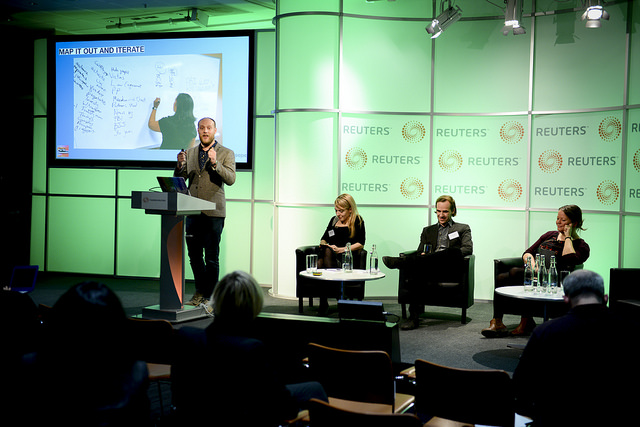 A newsroom is a diverse place where journalists have to work hand-in-hand with other professions to carry out their reporting. Innovative journalism projects involve collaborating with other journalists across the world, developers and so on. It has its benefits and its challenges, so what are the best practices to manage a successful collaboration inside newsrooms, across newsrooms and across departments? How does it work in practice and what are the long-lasting effects?
A newsroom is a diverse place where journalists have to work hand-in-hand with other professions to carry out their reporting. Innovative journalism projects involve collaborating with other journalists across the world, developers and so on. It has its benefits and its challenges, so what are the best practices to manage a successful collaboration inside newsrooms, across newsrooms and across departments? How does it work in practice and what are the long-lasting effects?
Three journalists shared their thoughts and experiences at newsrewired.
Recommendations from Sweden
Yasmine El Rafie, project manager and product owner at Swedish Radio, shared her thoughts about her team, Digitala insatsstyrkan, which was established two years ago. They help newsrooms inside the organisation with various initiatives, but they have to wait for their call to start a project – the team doesn’t produce their own content.
They do data journalism, research, data visualisation, you name it. “If it’s digital we do it,” said El Rafie.
As a first recommendation, she suggested learning from other projects. What went well, what went wrong, how are they structured? “When you try to form your team, try to do your homework. Think about what you want to build,” she said.
She provided some key advice for building a cross-disciplinary team:
- If starting something from scratch, set the tone from the beginning and deliver on it. Show how you do things, so they don’t change along the way. Then you can say: “This is how we’ve always done it.”
- Recruit smartly, gather a strong team. Select people that won’t mind having a different opinion or perspective.
- Think about your currency. What is valuable at your company – your time, staff, knowledge?
- When you say no, always say: Why?
For El Rafie’s team, staff is really important. One strategy they use is bringing in new editors every week to participate, but she still insisted it is important to stick to a structure. They have a routine and a lot of checklists that allow them to have this freedom.
“Knowledge is power. Act certain and they’ll believe you,” she said.
People sometimes see the word ‘collaboration’ and think that it is something disorganised, but it clearly involves a lot of structure. El Rafie said the key when several people are collaborating on a project is to focus on that one thing only. Working on several things at the same time can be stressful, but if you focus on one it can actually reduce stress.
“Eyes on the prize, stick to the gold, no matter what happens in the way,” she concluded.
A tool for collaboration
“How do we make journalism more about crossing borders, more international, more holistic?”, asked Felix Franz, project manager of Hostwriter, an online network for journalists that was founded based on the premise that to deliver the journalism we need in this complex world, the answer is collaboration. Franz firmly believes it is the key to quality journalism.
Hostwriter works easily – journalists create a profile and add some of their work samples. They go through an accreditation process, and once approved, they can start working with others. Today, hostwriter has around 3,200 journalists from 123 countries.
The network can be used to look for advice, to co-write a story or even as a “couchsurfing” platform if you need to stay at a colleague’s place while you are doing research on a project. The main idea is to bring the community closer, and it has been successful so far, with lots of collaborative stories published on the website.
A good example – Franz’s “baby”, as he called it – is the Agora Project, a temporary European newsroom for journalists collaborating on stories touching on topics of polarisation in various countries and communities in Europe. According to Franz, this project sums up what collaborative journalism can do.
Tech companies and journalism
Fergus Bell, co-founder of Pop-Up Newsroom, presented a project that aims to unlock best practices for collaboration between news organisations and technology companies.
“What is the point on finding something if you can’t communicate it efficiently – if you can’t process it?” said Bell. That’s where Pop-Up Newsroom comes in. It uses human-centered design to make digital communication more efficient, focusing on product design, editorial innovation and new business models at the same time.
Their take on collaboration is presence. “The first part of creating one of these projects is to ‘get physical’,” Bell said.
“We want everyone to be in the same place, at the same time and communicating with each other – not putting things in another Google Doc.”

